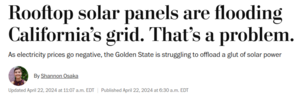GregBallantyne
Member
My number 2 goal being get rid of fossil fuels. I have a generator, but have avoided using it since getting my solar system (10 months in). But it requires some batteries, for when the sun lets you down for a few days. 26 grid outages here in those 10 months.... longest was 3 days, quite cloudy days. Self powered right through, it could have gone longer. Generator stayed quiet. Car didn't get charged much. Would love another 2-3 PW, but if finding the ROI was hard on the first three the second 3 won't help.I disagree. If reliability is the number one goal, it's very hard to beat a quality diesel or natural gas/propane generator. They work when it's cold and overcast, and they work in the dead of winter when you have fewer hours of charging time available, and they work when you have a large house and a lot of energy demand (if sized properly), and if diesel they can even be refueled by you with a decent storage container.
Batteries depend on solar,, and even in CA where I live we had some pretty grey days with power outages this past winder. 3 days of power outage, and my diesel generator didn't even get to 60% of tank storage.
Now, I am not talking about some cheap home depot gas unit that needs oil or rebuilding after a couple days of runtime. You want a quality unit,. But if you have one, it's far better than depending on the sun always being there for your family.
Last edited:




